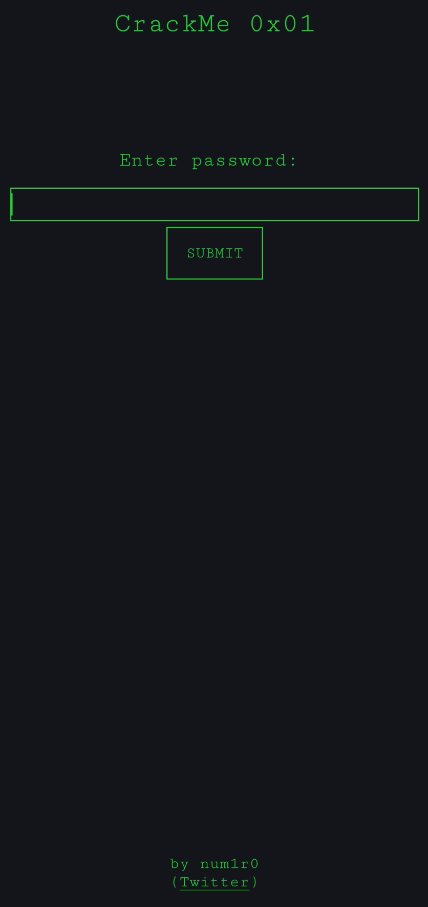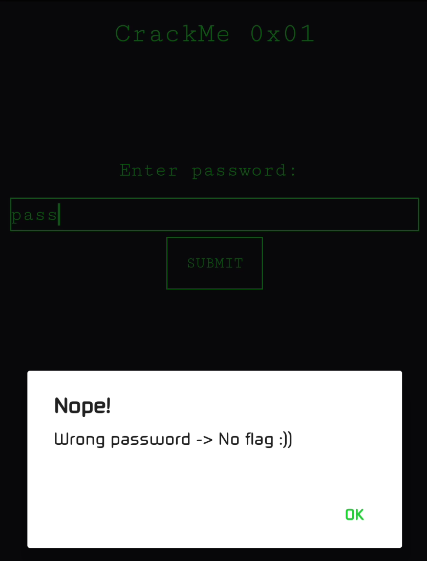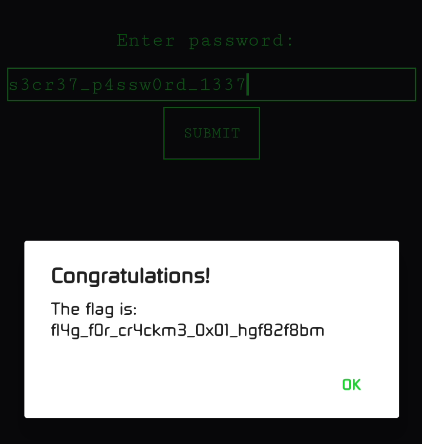-
Notifications
You must be signed in to change notification settings - Fork 5
Day 6 ‐ crackmes
So let's walk through the process of cracking an Android app. Taking some simple crackmes first, then moving on to more complex ones.
- Author: @num1r0
- Source: https://github.com/num1r0/android_crackmes.git
The very basic crackme challenge. Gives you chance to get familiar with all Android RE tools
As the description says, it's a very basic crackme. But it's a good starting point for learning Android RE.
Let's first install the app on our device and run it. And we're presented with a simple password input screen:

Let's try to enter some random password and see what happens:
 We get a toast message saying "Wrong password -> No flag :))". So let's try to find out how the app checks the password.
We get a toast message saying "Wrong password -> No flag :))". So let's try to find out how the app checks the password.
Now let's decompile the apk first. For that we have plenty of tools available:
- apktool
- jadx | jadx-gui
- dex2jar
- enjarify
- jd-gui
- CFR
- procyon
- fernflower
- jad
- javap
- jclasslib
- Krakatau
- Candle
- Smali/BakSmali
- bytecode-viewer
- JEB
- APKEditor
- APKLab
Also, we've our own RevEngi Bot Just inside Telegram for this task 😂
My Personal Favorites are apktool,APKEditor,JADX,baksmali(for this you need to extract .dex files out of apk), and MT of course in Android side.
Now, without further ado, whichever tool you've used doesn't matter what our goal here is to first go the place where the error string is or the place where the password is checked.
I'll be assuming you're familiar with how to search for strings at least.
So, after search we see that it's result leads to the class MainActivity$1 and the method onClick:
.method public onClick(Landroid/view/View;)V
.registers 5
new-instance p1, Lcom/entebra/crackme0x01/FlagGuard;
invoke-direct {p1}, Lcom/entebra/crackme0x01/FlagGuard;-><init>()V
iget-object v0, p0, Lcom/entebra/crackme0x01/MainActivity$1;->val$edtTxt:Landroid/widget/EditText;
invoke-virtual {v0}, Landroid/widget/EditText;->getText()Landroid/text/Editable;
move-result-object v0
invoke-virtual {v0}, Ljava/lang/Object;->toString()Ljava/lang/String;
move-result-object v0
invoke-virtual {p1, v0}, Lcom/entebra/crackme0x01/FlagGuard;->getFlag(Ljava/lang/String;)Ljava/lang/String;
move-result-object p1
if-eqz p1, :cond_47 // Compare if the value in our register p1 is null/0 or not
// If 0 then go to cond_47
// else just continue below code flow
new-instance v0, Landroid/support/v7/app/AlertDialog$Builder;
iget-object v1, p0, Lcom/entebra/crackme0x01/MainActivity$1;->this$0:Lcom/entebra/crackme0x01/MainActivity;
invoke-direct {v0, v1}, Landroid/support/v7/app/AlertDialog$Builder;-><init>(Landroid/content/Context;)V
const-string v1, "Congratulations!"
invoke-virtual {v0, v1}, Landroid/support/v7/app/AlertDialog$Builder;->setTitle(Ljava/lang/CharSequence;)Landroid/support/v7/app/AlertDialog$Builder;
new-instance v1, Ljava/lang/StringBuilder;
invoke-direct {v1}, Ljava/lang/StringBuilder;-><init>()V
const-string v2, "The flag is: "
invoke-virtual {v1, v2}, Ljava/lang/StringBuilder;->append(Ljava/lang/String;)Ljava/lang/StringBuilder;
invoke-virtual {v1, p1}, Ljava/lang/StringBuilder;->append(Ljava/lang/String;)Ljava/lang/StringBuilder;
invoke-virtual {v1}, Ljava/lang/StringBuilder;->toString()Ljava/lang/String;
move-result-object p1
invoke-virtual {v0, p1}, Landroid/support/v7/app/AlertDialog$Builder;->setMessage(Ljava/lang/CharSequence;)Landroid/support/v7/app/AlertDialog$Builder;
const-string p1, "OK"
new-instance v1, Lcom/entebra/crackme0x01/MainActivity$1$1;
invoke-direct {v1, p0}, Lcom/entebra/crackme0x01/MainActivity$1$1;-><init>(Lcom/entebra/crackme0x01/MainActivity$1;)V
invoke-virtual {v0, p1, v1}, Landroid/support/v7/app/AlertDialog$Builder;->setPositiveButton(Ljava/lang/CharSequence;Landroid/content/DialogInterface$OnClickListener;)Landroid/support/v7/app/AlertDialog$Builder;
invoke-virtual {v0}, Landroid/support/v7/app/AlertDialog$Builder;->create()Landroid/support/v7/app/AlertDialog;
move-result-object p1
invoke-virtual {p1}, Landroid/support/v7/app/AlertDialog;->show()V
goto :goto_69
:cond_47 // Conditional branch 47 to trigger Error Dialogue
new-instance p1, Landroid/support/v7/app/AlertDialog$Builder;
iget-object v0, p0, Lcom/entebra/crackme0x01/MainActivity$1;->this$0:Lcom/entebra/crackme0x01/MainActivity;
invoke-direct {p1, v0}, Landroid/support/v7/app/AlertDialog$Builder;-><init>(Landroid/content/Context;)V
const-string v0, "Nope!" // Error Title Message
invoke-virtual {p1, v0}, Landroid/support/v7/app/AlertDialog$Builder;->setTitle(Ljava/lang/CharSequence;)Landroid/support/v7/app/AlertDialog$Builder;
const-string v0, "Wrong password -> No flag :))" // The Error Message
invoke-virtual {p1, v0}, Landroid/support/v7/app/AlertDialog$Builder;->setMessage(Ljava/lang/CharSequence;)Landroid/support/v7/app/AlertDialog$Builder;
const-string v0, "OK"
new-instance v1, Lcom/entebra/crackme0x01/MainActivity$1$2;
invoke-direct {v1, p0}, Lcom/entebra/crackme0x01/MainActivity$1$2;-><init>(Lcom/entebra/crackme0x01/MainActivity$1;)V
invoke-virtual {p1, v0, v1}, Landroid/support/v7/app/AlertDialog$Builder;->setPositiveButton(Ljava/lang/CharSequence;Landroid/content/DialogInterface$OnClickListener;)Landroid/support/v7/app/AlertDialog$Builder;
invoke-virtual {p1}, Landroid/support/v7/app/AlertDialog$Builder;->create()Landroid/support/v7/app/AlertDialog;
move-result-object p1
invoke-virtual {p1}, Landroid/support/v7/app/AlertDialog;->show()V
:goto_69
return-void
.end methodWhen you look at it, it'll feel like a mess, but if you look at the :cond_47(remember :cond_ is the usual format the numbering can vary on your decompiled code) label, you'll see that it's the condition which is responsible for error dialogue message. So, If we want to just crack this check one of the most basic and easiest approach is nullifying this check. Just remove that line of if-eqz p1, :cond_47, and you'll be able to bypass the check. But, we're not here to just crack the check, we're here to learn. Also, if you just do this you'll be able to bypass the check and get the "Congratulations" dialogue, but you'll not be able to get the flag.

Hahahaha 😂, I know it's a bit of a disappointment, but it's not the end. Let's understand the flow of the code a bit more.
So, how is :cond_47 triggered?
Well, if you look at the if-eq instruction just above few lines of the code, you'll see that it's comparing the password you entered with the correct password. If they're not equal, it'll branch to :cond_47 and show the error message. So, how do we find the correct password?
The main piece of code:
new-instance p1, Lcom/entebra/crackme0x01/FlagGuard;
invoke-direct {p1}, Lcom/entebra/crackme0x01/FlagGuard;-><init>()V
iget-object v0, p0, Lcom/entebra/crackme0x01/MainActivity$1;->val$edtTxt:Landroid/widget/EditText;
invoke-virtual {v0}, Landroid/widget/EditText;->getText()Landroid/text/Editable;
move-result-object v0
invoke-virtual {v0}, Ljava/lang/Object;->toString()Ljava/lang/String;
move-result-object v0
invoke-virtual {p1, v0}, Lcom/entebra/crackme0x01/FlagGuard;->getFlag(Ljava/lang/String;)Ljava/lang/String;
move-result-object p1The first line is creating a new instance of FlagGuard class. The next line is calling the constructor of FlagGuard class. To Understand new-instance better you can read new-instance i've made sure to use this same example to make it easier for you to understand.
Now that If you're done with understanding new-instance let's move on to the next line(s).
Let’s break down the remaining lines of the Smali code:
iget-object v0, p0, Lcom/entebra/crackme0x01/MainActivity$1;->val$edtTxt:Landroid/widget/EditText;This grabs the EditText widget of android.widget.EditText and puts it into the v0 register. In Java, this would be something like this:
EditText editText = this.val$edtTxt;So, The box where we enter the password is stored in v0 register.
Next:
invoke-virtual {v0}, Landroid/widget/EditText;->getText()Landroid/text/Editable;
move-result-object v0This calls the getText() method on the EditText object (v0) and stores the result (the text inside the EditText) back in v0. In Java:
Editable text = editText.getText();Then, the text from the EditText is stored in v0 register.
The text is then converted to a string:
invoke-virtual {v0}, Ljava/lang/Object;->toString()Ljava/lang/String;
move-result-object v0In Java:
String textString = text.toString();Why? Well 🤨, because the getFlag() method of FlagGuard expects a String as an argument, so our password needs to be a String.
Finally, this line passes the string from the EditText to the getFlag() method of FlagGuard:
invoke-virtual {p1, v0}, Lcom/entebra/crackme0x01/FlagGuard;->getFlag(Ljava/lang/String;)Ljava/lang/String;
move-result-object p1In Java:
String flag = flagGuard.getFlag(textString);Here, the getFlag() method is called on the FlagGuard object (stored in p1), and the result (the flag) is stored in p1.
Well, we can't just look at the code and see what the password is. We need to analyze the getFlag() method to see how it checks the password. Since now it's clear from our initial analysis also that it's return value was being compared with 0 or not. 0 means the password is incorrect and anything else means the password is correct. But we tried to bypass the check 😜, but it didn't work. So, let's analyze the getFlag() method.
getFlag() method is defined in FlagGuard class. Let's open it up and see what's happening there.
.method public getFlag(Ljava/lang/String;)Ljava/lang/String;
.locals 1
.line 11
new-instance v0, Lcom/entebra/crackme0x01/Data;
invoke-direct {v0}, Lcom/entebra/crackme0x01/Data;-><init>()V
.line 12
invoke-virtual {v0}, Lcom/entebra/crackme0x01/Data;->getData()Ljava/lang/String;
move-result-object v0
invoke-virtual {p1, v0}, Ljava/lang/String;->equals(Ljava/lang/Object;)Z
move-result p1
if-eqz p1, :cond_0
.line 13
invoke-direct {p0}, Lcom/entebra/crackme0x01/FlagGuard;->unscramble()Ljava/lang/String;
move-result-object p1
return-object p1
:cond_0
const/4 p1, 0x0
return-object p1
.end methodHere, again we see that there's an instance of Data class has been created then from it getData() is being used to maybe for now let's assume to get some data from our string and return 0 or 1. If it returns 1 then unscramble() method is being called which is returning the flag.
We'll look at unscramble() method later, let's first analyze getData() method.
If we check the whole Data class:
.class public Lcom/entebra/crackme0x01/Data;
.super Ljava/lang/Object;
.source "Data.java"
# instance fields
.field private final secret:Ljava/lang/String;
# direct methods
.method public constructor <init>()V
.locals 1
.line 3
invoke-direct {p0}, Ljava/lang/Object;-><init>()V
const-string v0, "s3cr37_p4ssw0rd_1337"
.line 4
iput-object v0, p0, Lcom/entebra/crackme0x01/Data;->secret:Ljava/lang/String;
return-void
.end method
# virtual methods
.method public getData()Ljava/lang/String;
.locals 1
.line 7
invoke-virtual {p0}, Ljava/lang/Object;->getClass()Ljava/lang/Class;
const-string v0, "s3cr37_p4ssw0rd_1337"
return-object v0
.end methodAha, 🤯 it's returning the hard-coded string s3cr37_p4ssw0rd_1337 which seems to be most likely as our password. So, we need to pass this string to getFlag() method to get the flag. Let's try it out.

and wohooo🥳, we got the flag.
It's good 🤩 that we got the flag, but it's always good to know how it's being unscrambled. Let's check the unscramble() method.
.method private unscramble()Ljava/lang/String;
.locals 9
.line 21
new-instance v0, Ljava/lang/StringBuilder;
invoke-direct {v0}, Ljava/lang/StringBuilder;-><init>()V
const-wide v1, 0x4094e40000000000L # 1337.0
.line 22
invoke-static {v1, v2}, Ljava/lang/String;->valueOf(D)Ljava/lang/String;
move-result-object v1
const-string v2, "\\."
invoke-virtual {v1, v2}, Ljava/lang/String;->split(Ljava/lang/String;)[Ljava/lang/String;
move-result-object v1
const/4 v2, 0x0
aget-object v1, v1, v2
invoke-static {v1}, Ljava/lang/Integer;->valueOf(Ljava/lang/String;)Ljava/lang/Integer;
move-result-object v1
invoke-virtual {v1}, Ljava/lang/Integer;->intValue()I
move-result v1
const-string v3, "qw4r_q0c_nc4nvx3_0i01_srq82q8mx"
.line 23
invoke-virtual {v3}, Ljava/lang/String;->toCharArray()[C
move-result-object v3
array-length v4, v3
:goto_0
if-ge v2, v4, :cond_2
aget-char v5, v3, v2
const-string v6, "Char: "
.line 24
invoke-static {v5}, Ljava/lang/String;->valueOf(C)Ljava/lang/String;
move-result-object v7
invoke-static {v6, v7}, Landroid/util/Log;->e(Ljava/lang/String;Ljava/lang/String;)I
const-string v6, "abcdefghijklmnopqrstuvwxyz"
.line 26
invoke-virtual {v6, v5}, Ljava/lang/String;->indexOf(I)I
move-result v6
const-string v7, "indexOf: "
.line 27
invoke-static {v6}, Ljava/lang/String;->valueOf(I)Ljava/lang/String;
move-result-object v8
invoke-static {v7, v8}, Landroid/util/Log;->e(Ljava/lang/String;Ljava/lang/String;)I
if-gez v6, :cond_0
.line 29
invoke-static {v5}, Ljava/lang/String;->valueOf(C)Ljava/lang/String;
move-result-object v5
goto :goto_1
:cond_0
sub-int/2addr v6, v1
const-string v5, "abcdefghijklmnopqrstuvwxyz"
.line 31
invoke-virtual {v5}, Ljava/lang/String;->length()I
move-result v5
rem-int/2addr v6, v5
if-gez v6, :cond_1
const-string v5, "abcdefghijklmnopqrstuvwxyz"
.line 33
invoke-virtual {v5}, Ljava/lang/String;->toCharArray()[C
move-result-object v5
const-string v7, "abcdefghijklmnopqrstuvwxyz"
invoke-virtual {v7}, Ljava/lang/String;->length()I
move-result v7
add-int/2addr v6, v7
aget-char v5, v5, v6
invoke-static {v5}, Ljava/lang/String;->valueOf(C)Ljava/lang/String;
move-result-object v5
goto :goto_1
:cond_1
const-string v5, "abcdefghijklmnopqrstuvwxyz"
.line 35
invoke-virtual {v5}, Ljava/lang/String;->toCharArray()[C
move-result-object v5
aget-char v5, v5, v6
invoke-static {v5}, Ljava/lang/String;->valueOf(C)Ljava/lang/String;
move-result-object v5
:goto_1
const-string v6, "letter "
.line 37
invoke-static {v6, v5}, Landroid/util/Log;->e(Ljava/lang/String;Ljava/lang/String;)I
.line 38
invoke-virtual {v0, v5}, Ljava/lang/StringBuilder;->append(Ljava/lang/String;)Ljava/lang/StringBuilder;
add-int/lit8 v2, v2, 0x1
goto :goto_0
:cond_2
const-string v1, "FLAG: "
.line 40
invoke-virtual {v0}, Ljava/lang/StringBuilder;->toString()Ljava/lang/String;
move-result-object v2
invoke-static {v1, v2}, Landroid/util/Log;->e(Ljava/lang/String;Ljava/lang/String;)I
.line 41
invoke-virtual {v0}, Ljava/lang/StringBuilder;->toString()Ljava/lang/String;
move-result-object v0
return-object v0
.end methodWait, before that did you see those code lines with Landroid/util/Log;->e(Ljava/lang/String;Ljava/lang/String;)I They're responsible for writing to the logcat. So, it seems that the app is logging the flag. In that case we could've solved it using MT Log injection or by fetching its logcat through adb. Or we can solve it by bypassing the second check at of getData() at getFlag() method also.
Aha, if you look at the decompiled code, you can see that it's doing some weird stuff with the alphabet. It's shifting the letters by the index of the input character, wrapping around the end of the alphabet, and appending the result to a string.
new-instance v0, Ljava/lang/StringBuilder;
invoke-direct {v0}, Ljava/lang/StringBuilder;-><init>()VIn Java, this corresponds to:
StringBuilder sb = new StringBuilder();So, The method first starts by creating an instance of StringBuilder class object, which will be used to build the final unscrambled string. Again if you want to know about new-instance you can refer to new-instance.
const-wide v1, 0x4094e40000000000L # 1337.0
invoke-static {v1, v2}, Ljava/lang/String;->valueOf(D)Ljava/lang/String;
move-result-object v1Here, the value 1337.0 is loaded into registers as a double(why? Lol, I remember telling you about necessary mnemonics in smali right? Did you forget that? Huh, 😒 anyway check valueOf contains D inside it's brackets and D means double (64 bit) in smali). It converts the double into a string representation using valueOf().
In Java:
String str = String.valueOf(1337.0);It's converting 1337.0 into the string "1337"
const-string v2, "\\."
invoke-virtual {v1, v2}, Ljava/lang/String;->split(Ljava/lang/String;)[Ljava/lang/String;
move-result-object v1In Java:
String[] parts = str.split("\\.");The method splits the string "1337.0" on the . character. This results in the array ["1337", "0"].
aget-object v1, v1, v2
invoke-static {v1}, Ljava/lang/Integer;->valueOf(Ljava/lang/String;)Ljava/lang/Integer;
move-result-object v1
invoke-virtual {v1}, Ljava/lang/Integer;->intValue()I
move-result v1The string "1337" is converted into an integer:
int num = Integer.valueOf(parts[0]);So, v1 now holds the integer value 1337. This number is key to unscrambling the characters.
const-string v3, "qw4r_q0c_nc4nvx3_0i01_srq82q8mx"
invoke-virtual {v3}, Ljava/lang/String;->toCharArray()[C
move-result-object v3The scrambled string "qw4r_q0c_nc4nvx3_0i01_srq82q8mx" is loaded and converted into a character array.
In Java:
char[] scrambled = "qw4r_q0c_nc4nvx3_0i01_srq82q8mx".toCharArray();The method is now preparing to loop through each character and unscramble it.
:goto_0
if-ge v2, v4, :cond_2
aget-char v5, v3, v2In Java:
for (int i = 0; i < scrambled.length; i++) {
char c = scrambled[i];
}The loop goes through each character in the scrambled string, storing the current character in v5.
invoke-static {v5}, Ljava/lang/String;->valueOf(C)Ljava/lang/String;
move-result-object v7
invoke-static {v6, v7}, Landroid/util/Log;->e(Ljava/lang/String;Ljava/lang/String;)ISkip...
In Java:
Log.e("Char: ", String.valueOf(c));Skip, skip....
const-string v6, "abcdefghijklmnopqrstuvwxyz"
invoke-virtual {v6, v5}, Ljava/lang/String;->indexOf(I)I
move-result v6The method looks for the character's position in the alphabet. If the character is found in the string "abcdefghijklmnopqrstuvwxyz", its index is returned. In Java:
int index = "abcdefghijklmnopqrstuvwxyz".indexOf(c);If the character is found in the alphabet (i.e., index >= 0, using if-gez instrunction ), the method adjusts its position based on the value 1337:
sub-int/2addr v6, v1
rem-int/2addr v6, v5The first one subtracts 1337 from the index and wraps it around if necessary, then second one using the remainder (rem-int) to ensure the new index is within the bounds of the alphabet.
In Java:
int newIndex = (index - 1337) % 26;
if (newIndex < 0) {
newIndex += 26;
}Finally, the unscrambled character is appended to the StringBuilder:
invoke-virtual {v0, v5}, Ljava/lang/StringBuilder;->append(Ljava/lang/String;)Ljava/lang/StringBuilder;In Java:
sb.append(unscrambledChar);This is repeated for every character in the scrambled string.
So, The unscramble() method is essentially a Caesar-like cipher, where each character in the scrambled string is shifted by a large value (1337), wrapped around the alphabet if necessary, and logged along the way. It builds the unscrambled string using a StringBuilder and finally returns it.
Which will result in: fl4g_f0r_cr4ckm3_0x01_hgf82f8bm
It felt overly complicated right? However, with time and practice, you will get used to it. And when you do instead of wasting time reading understanding this whole process you'll start writing simple scripts to automate these tasks, like at first glance I felt from the method name, double 1337 value and shifting that it's kinds ceaser shift operation, so I would write a simple python script to unscramble it. Like this one below:
scrambled = "qw4r_q0c_nc4nvx3_0i01_srq82q8mx"
alphabet = "abcdefghijklmnopqrstuvwxyz"
shift = 1337
print(
"".join(
(alphabet[(alphabet.index(char) - shift) % 26] if char in alphabet else char)
for char in scrambled
)
)Hope this helps and you enjoyed reading this.
Happy Reversing!